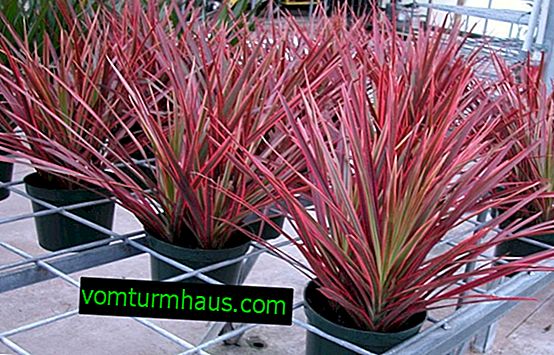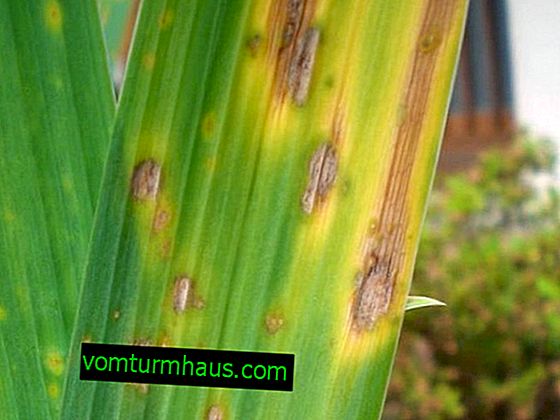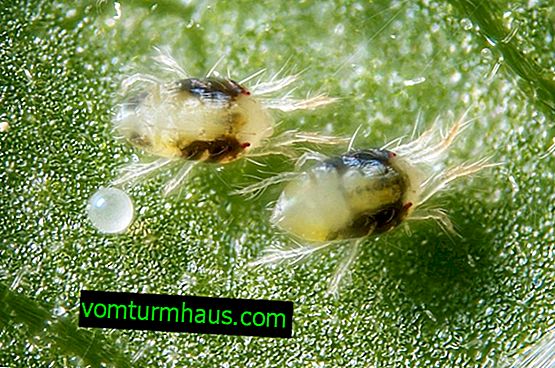Dracaena edged: description of the plant, especially the care at home
Dracaena can be called one of the most common plants for indoor floriculture. There are many varieties of it that have an interesting color and shape of leaves, but today we will consider a description of bordered dracaena - the most popular bent dracaena subspecies for housing, as well as the features of its cultivation and care.
Plant description
In the wild, dracaena fringed (another name is marginate) grows in the form of a slender evergreen tree. In height, it often reaches 5 m. The trunk of the tree is straight, has a minimum of branches, with age it may lose lower leaves, in the place of which trapezoid scars form. The plant has linear leaves that are arranged in dense tufts at the apex.
The leaves of dracaena are very stiff, straight and narrow, up to 1-2 cm wide and 50–70 cm long. They are parallel venation, which closes at the top of each leaf. Its name “bordered” dracaena got due to the unusual coloring of leaves: bright green with reddish-purple bordering on the edges.
Did you know? Dracaena is even credited with magical properties, such as cleaning the house and charging the room with positive energy. Marginata calms, improves mood.
Bordered dracaena has several varieties with a more original color:
- “Tricolor” - contains 3 colors on a sheet: green, yellow and red, which are drawn in the form of vertical lines;

- "Colorama" - has wide vertical red stripes on the sheet;

- "Bicolor" - characterized by the presence of longitudinal pink stripes on a sheet plate;

- "Magenta" - has leaves with a thin raspberry border on the sides.

Advantages and disadvantages
- The main advantages of bordered dracaena include:
- availability for purchase;
- the ability to clean the air of harmful impurities and toxic substances;
- simplicity in leaving;
- undemanding to growing conditions;
- beautiful appearance;
- medicinal properties of the resin secreted by piercing the trunk: antibacterial, antiviral, wound healing, antitumor;
- strengthening immunity when consuming tar from a plant stem.
- The main disadvantages of this plant are:
- the large size of adult specimens, which sometimes grow taller than the height of the ceiling allows;
- medium resistance to diseases and pests.












Basic requirements for growing
Despite the unpretentiousness of bordered dracaena, in the process of its cultivation, it is recommended to take into account the basic requirements:
- it grows in soil with neutral acidity;
- a pot for planting choose a tall, but small diameter;
- compliance with the temperature regime;
- regular feeding;
- transplantation every 2-3 years;
- regular watering and spraying, depending on the time of year;
- choosing the right place for the pot in terms of lighting.
Important! Choose a place to place the pot so that the flower does not suffer from drafts and strong winds.
Features of home care
Dracaena requires regular care, which consists of timely watering, fertilizing, transplanting, as well as machining of the leaf part. Consider how to properly care for the dracaena bordered.
Optimal conditions
Dracaena grows well while observing the temperature standards in the room, which vary from 20 to 25 ° C in the summer and from 15 ° C and above in the winter. In summer, dracaena is best taken outdoors. The plant needs good lighting, but it reacts very poorly to direct sunlight, so choose a western or eastern window for placement. If the marginate lacks sunlight, the leaves will begin to fade and decorativeness will decrease.

Watering and fertilizer
Dracaena loves moist soil, so it needs abundant and regular watering. It is absolutely impossible to dry the earthen lump; it is better to keep it constantly in a wet state. But the plant can respond to excessive watering by rotting the root system and death. In summer, the flower is watered every other day, and in winter, watering is reduced to 1-2 times a week.
Did you know? The Aztecs, who called it the "tree of happiness, " were very popular dracaena. And from Latin, "dracaena" is translated as "female dragon."
In addition, you need to regularly spray the leaf part from the spray gun, in the summer - 2-3 times a day, in the winter - 1-2 times a day. The plant should be fed during the period when active growth begins - usually it lasts from March to August. At this time, any complex fertilizers for dracenes are introduced into the soil, according to the instructions. Usually, feeding is carried out 2 times a month.
Trimming and shaping a bush
In order for a large beautiful tree to grow from a small sprout, it is necessary to cut branches and form a crown of a tree. Before trimming the excess part of the stem, you need to understand the types of pruning and the intricacies of its implementation. Due to the fact that the dracaena has sleeping points along the entire length of the stem, wherever the cut is made, a young shoot will surely grow in its place.
Trimming dracaena is recommended during the period of active growth (May - June), when the processes of sap flow from all parts are best established. There are cases of unplanned pruning, for example, if the stem is accidentally broken off - then it is cut below the break point.
The first pruning is carried out when the length of the main stem is about 30 cm. You can trim both leafy shoots and bare ones. The procedure is carried out with a sharp clean knife with sharp movements. Then all leaves are removed 10 cm below the cut, and the cut itself is sealed with liquid paraffin.

Every week, you need to remove the package and check the stem for new sprouts. If the first buds of new shoots were noticed, then the packet and sphagnum no longer need to be used. Anti-aging pruning is no different from normal. It is carried out when the plant reaches large sizes and needs to be shortened. You can shorten it to any length, that is, leave the stem as large as you want.
Important! When pruning dracaena, leave a trunk at least 10 cm high in the pot, otherwise it may die.
Plant transplant
Dracaena, like all indoor flowers, needs regular transplants. A transplant is best done in early spring, when active plant growth begins.
It is possible to determine whether a margin needs a transplant by the following signs:
- the root system grows so much that some roots come out of the pot;
- rotting of the roots began, which is determined by wilting leaves and an unpleasant putrefactive smell from the pot;
- the substrate is completely depleted, which occurs 2-3 years after the last transplant;
- the plant was affected by pests that develop in the soil.

For transplantation, choose a pot with a diameter of 2-3 cm larger than the previous one. At the bottom of the tank must be present holes that allow excess fluid to leak out. Suitable soil composition: leafy soil (2 parts), sod (1 part), compost (1 part), peat (0.5 part).
The transplant should be carried out as follows:
- Put drainage - expanded clay (4 cm) at the bottom of the pot.
- On top of expanded clay, pour a little prepared soil mixture.
- Carefully remove the flower from the container, keeping the earthen lump intact.
- Free the roots from the ground and carefully examine for the presence of dead, damaged, decayed or affected by diseases (pests) areas.
- Cut off all the bad parts of the roots with a sharp knife, affecting some living tissue.
- Process sections of the cuts with crushed charcoal.
- Spray the roots with warm water from a spray bottle and immerse in a pot.
- Pour the remaining soil mixture over the roots and distribute it well in a pot.
- In the process of adding soil in the pot, it must be compacted, periodically tapping the container on the surface of the table or floor.
- The soil around the stem needs to be slightly tamped to fix the plant well.
Video: how to transplant dracaena
Breeding
It is better to propagate bordered Dracaena in the spring-summer period and combine reproduction with planned pruning. To perform the procedure, it is necessary to prepare a sharp knife treated with alcohol.
The cut off part can be put into water, so that after a while it takes root, or immediately plant the cut off part in the soil. The second method is used more often, since part of the stem rots in the water. Therefore, we consider in more detail the process of planting a cut stem in the soil.
Learn more about fragrant dracaena and dragon dracaena.
If the length of the stem, due to the existing leaves at the top, is less than 5 cm, it is necessary to remove several lower leaves. For planting, use a small pot, not more than 9 cm in diameter, fill it with peat soil, be sure to lay drainage (expanded clay) to the bottom. In the soil, make a deepening and install the cut off part of dracaena there, having previously dipped the end in the Kornevin preparation for better rooting.
Keep the plant in a warm room - 25–26 ° C, spray the leaves and regularly water, observing the same regimen as in caring for rooted dracaenas. Adequate lighting should be provided to the flower by installing it on a diffused light window.
Video: propagation of dracaena by cuttings
Possible growing problems
Dracaena can respond to improper care by impaired growth, discoloration of the leaves, or the occurrence of a number of diseases.
Let us consider in more detail the possible problems that arise during the cultivation of dracaena, and what needs to be done in such situations:
- The leaves turn yellow and fall off - such a problem can occur with improper watering. Initially, the tips begin to turn yellow, then the entire leaf dries and soon falls off. Marginate should be treated by normalizing the irrigation regime and drying an earthen coma. You can dry the earth by taking the plant out of the pot and temporarily wrapping several layers of paper so that it absorbs excess fluid.
- The ends of the leaves are dry - the drying of the ends can be provoked by dry air or lack of fertilizing. To solve the problem, it is necessary to install a container with moist expanded clay near the pot, moisten the leaves with spraying and follow the recommendations for feeding.
- Leaves are covered with brown spots - the plant received a burn under the influence of direct sunlight. It will not be possible to get rid of stains, but so that the leaves do not receive new burns, the pot should be rearranged in partial shade.

- Leaves rot - a lack of light and heat combined with excessive watering. To save the plant, the affected leaves must be removed, the earthen lump dried, the pot removed in a warm and bright place, and also observe the irrigation regime.

- Young leaves turn black - this problem may occur due to the lack of transplants or an excessive amount of fertilizing. To solve the problem, the flower should be transplanted, and fertilizer should be applied not so often.
Also, problems in the cultivation of dracaena can occur under the influence of diseases.
Among them, several types of fungal spotting can be distinguished:
- alternariosis - manifested by rounded brown or black spots, which eventually cover the entire surface of the sheet, and it falls off;

- heterosporosis - yellow spots that often spread over the entire surface of the leaf plate and acquire a dark brown color.

Fungal spotting should be treated using any special antifungal drugs for dracaena, according to the instructions.
We recommend that you find out why dracaena drops leaves and what to do.
Pests that can sometimes affect dracaena:
- Scale is an insect that sucks the juice from the leaves, because of which they dry and fall off. You can destroy the pest by treating the leaves with Fitoverm, according to the instructions.

- A spider mite is a tiny arachnid that settles on the back of the leaves and, over time, braids around it with a web. It is necessary to treat the plant by treating the leaf plates with a soap solution (lather with soap and rinse with hot water at a temperature of about 50 ° C).

- Mealybug - an insect that covers the plant with spots and white coating. To treat dracaena, you need to remove the worms with a soap solution, as in the case of spider mites. A minimum of 3-4 treatments should be performed at intervals of 1 week.

So, to grow dracaena fringed at home is quite simple. A tall plant with a cap of beautiful colorful leaves can turn the room into a real greenhouse or winter garden. The main thing is to follow the basic recommendations for care and maintain optimal microclimate conditions in the room.














